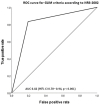GLIM in diagnosing malnutrition and predicting outcome in ambulatory patients with head and neck cancer
- PMID: 36483923
- PMCID: PMC9724589
- DOI: 10.3389/fnut.2022.1030619
GLIM in diagnosing malnutrition and predicting outcome in ambulatory patients with head and neck cancer
Abstract
Aim: This study aimed to determine the prevalence of malnutrition in a head and neck cancer (HNC) population according to the Global Leadership Initiative on Malnutrition (GLIM) criteria and to assess its relation to survival. The secondary aim was to compare GLIM criteria to Patient-Generated Subjective Global Assessment (PG-SGA) and Nutritional Risk Screening 2002 (NRS 2002) methods.
Methods: The assessment was performed in a series of 65 curative patients with newly diagnosed HNC in a nutrition intervention study. Malnutrition was defined as PG-SGA classes BC and nutritional risk as NRS 2002 score ≥3 and was retrospectively diagnosed with GLIM criteria in prospectively collected data at diagnosis. Sensitivity, specificity, and kappa (κ) were analyzed. Predictive accuracy was assessed by calculating the area under curve (AUC) b y receiver operating characteristic (ROC) analysis. Kaplan-Meier and Cox regression analyses were used to evaluate association between malnutrition and overall survival (OS), and disease-free survival (DFS).
Results: GLIM-defined malnutrition was present in 37% (24/65) of patients. The GLIM showed 77% sensitivity and 84% specificity with agreement of κ = 0.60 and accuracy of AUC = 0.80 (p < 0.001) with PG-SGA and slightly higher sensitivity (83%) with NRS 2002 (κ = 0.58). Patients with GLIM-defined malnutrition had shorter OS (56 vs. 72 months, HR 2.26, 95% CI 1.07-4.77, p = 0.034) and DFS (37 vs. 66 months, HR 2.01, 95% CI 0.99-4.09, p = 0.054), than well-nourished patients. The adjusted HR was 2.53 (95% CI 1.14-5.47, p = 0.023) for OS and 2.10 (95% CI 0.98-4.48, p = 0.056) for DFS in patients with GLIM-defined malnutrition.
Conclusion: A substantial proportion of HNC patients were diagnosed with malnutrition according to the GLIM criteria and this showed a moderate agreement with NRS 2002- and PG-SGA-defined malnutrition. Even though the GLIM criteria had strong association with OS, its diagnostic value was poor. Therefore, the GLIM criteria seem potential for malnutrition diagnostics and outcome prediction in the HNC patient population. Furthermore, NRS 2002 score ≥3 indicates high nutritional risk in this patient group.
Keywords: Patient-Generated Subjective Global Assessment; head and neck cancer; malnutrition; nutrition status; nutrition status assessment; nutritional risk; nutritional risk screening 2002; survival.
Copyright © 2022 Orell, Pohju, Osterlund, Schwab, Ravasco and Mäkitie.
Conflict of interest statement
The authors declare that the research was conducted in the absence of any commercial or financial relationships that could be construed as a potential conflict of interest.
Figures



Similar articles
-
Global Leadership Initiative on Malnutrition criteria as a nutrition assessment tool for patients with cancer.Nutrition. 2021 Nov-Dec;91-92:111379. doi: 10.1016/j.nut.2021.111379. Epub 2021 Jun 29. Nutrition. 2021. PMID: 34303957
-
Comparison of the Efficacy of the Global Leadership Initiative on Malnutrition Criteria, Subjective Global Assessment, and Nutrition Risk Screening 2002 in Diagnosing Malnutrition and Predicting 5-Year Mortality in Patients Hospitalized for Acute Illnesses.JPEN J Parenter Enteral Nutr. 2021 Aug;45(6):1172-1180. doi: 10.1002/jpen.2016. Epub 2020 Sep 28. JPEN J Parenter Enteral Nutr. 2021. PMID: 32914877
-
Scored-GLIM as an effective tool to assess nutrition status and predict survival in patients with cancer.Clin Nutr. 2021 Jun;40(6):4225-4233. doi: 10.1016/j.clnu.2021.01.033. Epub 2021 Jan 29. Clin Nutr. 2021. PMID: 33579553
-
The global leadership initiative on malnutrition criteria for the diagnosis of malnutrition in patients admitted to the intensive care unit: A systematic review and meta-analysis.Clin Nutr. 2023 Feb;42(2):182-189. doi: 10.1016/j.clnu.2022.12.007. Epub 2022 Dec 16. Clin Nutr. 2023. PMID: 36599273
-
Prevalence of malnutrition based on global leadership initiative in malnutrition criteria for completeness of diagnosis and future risk of malnutrition based on current malnutrition diagnosis: systematic review and meta-analysis.Front Nutr. 2023 Jul 4;10:1174945. doi: 10.3389/fnut.2023.1174945. eCollection 2023. Front Nutr. 2023. PMID: 37469547 Free PMC article.
Cited by
-
Development and validation of a novel prognostic prediction system based on GLIM-defined malnutrition for colorectal cancer patients post-radical surgery.Front Nutr. 2024 Oct 22;11:1425317. doi: 10.3389/fnut.2024.1425317. eCollection 2024. Front Nutr. 2024. PMID: 39502874 Free PMC article.
-
The relationship between GLIM-malnutrition, post-operative complications and long-term prognosis in elderly patients undergoing colorectal cancer surgery.J Gastrointest Oncol. 2023 Oct 31;14(5):2134-2145. doi: 10.21037/jgo-23-543. Epub 2023 Sep 28. J Gastrointest Oncol. 2023. PMID: 37969837 Free PMC article.
-
Diagnostic performance of GLIM and PG-SGA for malnutrition assessment in adult cancer patients: a systematic review and meta-analysis.BMC Cancer. 2025 Apr 23;25(1):765. doi: 10.1186/s12885-025-13809-6. BMC Cancer. 2025. PMID: 40269782 Free PMC article.
-
Global epidemiological characteristics of malnutrition in cancer patients: a comprehensive meta-analysis and systematic review.BMC Cancer. 2025 Jul 19;25(1):1191. doi: 10.1186/s12885-025-14558-2. BMC Cancer. 2025. PMID: 40684092 Free PMC article.
-
Delineation of the "Oropharyngeal Mucosa" and Limiting its Dose in Head and Neck Cancer Patients Spares the Oropharynx Without Compromising Target Coverage.Cancer Control. 2024 Jan-Dec;31:10732748241283621. doi: 10.1177/10732748241283621. Cancer Control. 2024. PMID: 39275798 Free PMC article.
References
-
- Liposits G, Orrevall Y, Kaasa S, Österlund P, Cederholm T. Nutrition in cancer care: a brief, practical guide with a focus on clinical practice. JCO Oncol Pract. (2021) 7:1–7. 10.1200/OP.20.00704 - DOI
LinkOut - more resources
Full Text Sources

